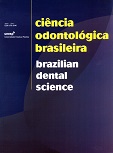Evaluation of the efficiency of an infection control protocol in dental radiology by means of microbiological analysis
DOI:
https://doi.org/10.14295/bds.2004.v7i3.301Resumo
The aim of this study was to verify the efficiency of an infection control protocol in dental radiology during radiographic exposure and processing, since the prevention of infectious diseases should be a matter of concern of the professional in all procedures. The areas selected for material collection were the film, tube head, dental chair, lead apron, buttons, protective barrier, darkroom bench and processing solutions (developer solution, water and fixer solution). Material was collected from each area both before and after establishment of the infection control protocol. Ten RODAC plates were employed for each site, adding up to 140 plates (70 before and 70 after), besides 60 Petri plates (30 before and 30 after) containing blood agar as the culture medium. The processing solutions were dropped on the Petri plates, whereas the material collected from the other areas was directly collected on the RODAC plates. All plates were incubated at 37ºC for 48 hours and after this period the number of colonies in each plate was counted. The Wilcoxon test revealed statistically significant differences (p=0.002) between the results before and after establishment of the proposed infection control protocol. It was concluded that the present protocol reduced the number of microorganisms on the analyzed surfaces and processing solutions.Downloads
Downloads
Publicado
Como Citar
Edição
Seção
Licença
TRANSFERÊNCIA DE DIREITOS AUTORAIS E DECLARAÇÃO DE RESPONSABILIDADE
Toda a propriedade de direitos autorais do artigo "____________________________________________________________________" é transferido do autor(es) para a CIÊNCIA ODONTOLÓGICA BRASILEIRA, no caso do trabalho ser publicado. O artigo não foi publicado em outro lugar e não foi submetido simultaneamente para publicação em outra revista.
Vimos por meio deste, atestar que trabalho é original e não apresenta dados manipulados, fraude ou plágio. Fizemos contribuição científica significativa para o estudo e estamos cientes dos dados apresentados e de acordo com a versão final do artigo. Assumimos total responsabilidade pelos aspectos éticos do estudo.
Este texto deve ser impresso e assinado por todos os autores. A versão digitalizada deverá ser apresentada como arquivo suplementar durante o processo de submissão.




























